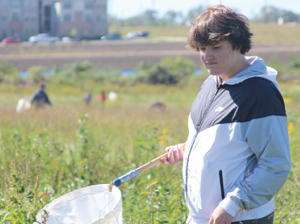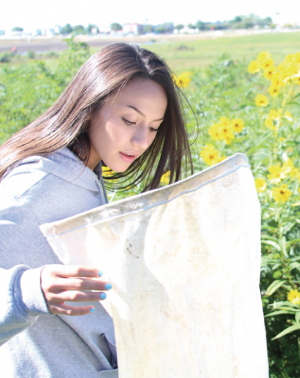Taking Flight
Field biology classes learn importance of monarch butterflies

Surveying the field for monarchs, sophomore Aiden Haynes holds a net. “It was fun to go outside and learn about butterflies,” Haynes said.
The monarch butterflies are one of the most known of their species for their vibrant orange wings and large size. They can be seen fluttering through prairies and tall grasses in the Midwest.
October is the starting month for the annual monarch butterfly migration. During the spring and summer, monarch butterflies start their journey to the south, which takes an average of 1,800 to 3,000 miles of flying.
They will reach their destination in the oyamel trees of the Michoacan and other Mexico states, where they will remain for the winter season.
Science teacher Kale Mann said he teaches his students about the butterfly migration because it is a “scientific mystery” most people don’t know about.

Shaking a net, sophomore Mac Demo walks through the field. “[Catching butterflies] was a fun way to get extra credit for the class,” Demo said.
Mann said he also likes to focus on the monarchs because of their migratory patterns.
“They give us a good indication of our entire North American grassland area,” Mann said. “By studying this one creature, [we gain] insight on how our continent is doing on our natural health.”
Mann said the monarch’s declining population has made them a species of concern. He said students can get involved in helping the monarch population on their own in addition to what they are doing as part of the curriculum.
“Something to do at home would be to plant nectar sources like milkweed,” Mann said. “You can also join Monarch Watch, the premiere conservation group [who] are tagging the monarchs. They are also reaching out to people, giving out grants and distributing milkweed to organizations that have land to plant it. Anything that involves helping native grasslands would be helpful.”

Looking for a monarch, senior Angelina Borisky checks her net. “It was really fun and something I have never done before and probably would have never thought of doing,” Borisky said.
Mann said the butterflies should be protected because they are part of nature.
“Everything that is present in our environment needs to be there,” Mann said. “If we lose pieces of the environment, the environment as a whole is less healthy [and] less able to respond to changes, which [could] have effects that we don’t even anticipate. It can even affect our health and our livelihood.”

Noma Kreegar is a senior and the Editor in Chief for “The Tiger Print.” She is also involved in Tiger TV and is the vice president of BV’s Young...




